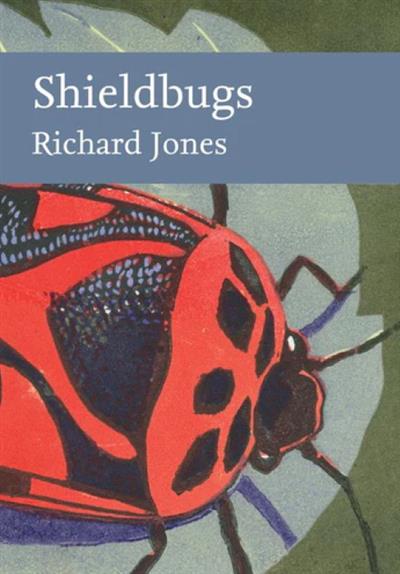Richard Jones
Harper Collins
2023
ISBN: 9780008334895
Reviewed by Alex Ramsay
Whilst numerous books are available for more popular insect groups such as butterflies, dragonflies or bumblebees, relatively few guides are published on other groups so the publication of a new book on shieldbugs is something of a rarity. Richard Jones has previously published a similar offering in the New Naturalist series on beetles, and readers who have purchased that book will be familiar with the author’s readable and often light-hearted style.
Chapters include: What is a shieldbug?; Shieldbug Structure; Life Histories: Breeding & Feeding; Dangers and Defences; Evolution of Shieldbugs and a History of British Species; History of Shieldbug Study; Keys to British Shieldbug Species; British Shieldbug Species and How to Study Shieldbugs. Inevitably the keys and species accounts make up the majority of the book with 184 pages.
Coverage includes all species in the Pentatomorpha with the exception of flatbugs Aradidae and ground or seed bugs (formerly Lygaeidae but now comprising a number of families), a format that follows previous books such as Roger Hawkins’s Shieldbugs of Surrey (2003), which included additional groups to the ‘traditional’ shieldbugs. Families included are the ‘traditional’ shieldbug families Acanthosomatidae, Cydnidae, Pentatomidae, Plataspidae, Scutelleridae and Thyreocoridae, with allied groups Alydidae, Coreidae, Pyrrhocoridae, Rhopalidae and Stenocephalidae also included. The status of many families is currently under review due to recent advances in molecular genetics, notably amongst the Cydnidae (e.g., Lis & Domagała, 2024), to which the Thyreocoridae is often now regarded as a subfamily (Schuh & Weirauch, 2020).
A total of 108 species is included, a mix of 79 species regarded as resident, and further species comprising species not yet recorded in Britain (but in many cases present in the Channel Islands) and additional vagrant species. The author admits that the inclusion of additional species could be regarded as arbitrary, and in many cases there is no way of predicting which species could occur in the future. Recent additions to the fauna include the impressively large pentatomid Rhaphigaster nebulosa and the more cryptic pentatomid Sciocoris sideritis, both of which are more typical of the Mediterranean, and further additions could include, for example, other species of Sciocoris which are widespread throughout Europe. All species are keyed out, however the difficulties of identification for genera such as the pentatomids Carpocoris, Sciocoris and certain Cydnids is perhaps understated, with Carpocoris in particular enormously variable in colour even within a single population.
There are a few errors as might be expected with a book of this size, notably the key to species including three photographs of the Cydnid Adomerus biguttatus, whilst photographs of Sehirus species and Canthophorus impressus are not included (but are present in the species accounts). The very yellow colour of the photo of Palomena prasina in the key and species account suggests it is more distinct from P. viridissima than it actually is. Taxonomic updates subsequent to the checklist of Palearctic Heteroptera (Aukema & Rieger, 2006) have not been included and can make the text seem dated. Eysarcoris venustissimus is now Stagonomus venustissimus (Roca-Cusachs & Jung, 2019), and all other European species of Holcogaster (H. exilis Horvath, 1903 and H. weberi Wagner, 1964) are now regarded as Holcogaster fibulata having been synonymised by Ribes & Gapon (2006). Cydnus aterrimus is incorrectly referred to as Canthophorus aterrimus in the species accounts.
Species which are currently resident in Britain and potential new species are both included in the same chapter, and it may perhaps have been more useful to split current resident species from species which have not yet been recorded so as to aid current understanding of the resident fauna, nevertheless the coverage provides a good introduction to both current and future faunal additions.
New species are turning up in Britain all the time but are not always recorded in the most obvious places – the first British record of the pentatomid Chroantha ornatula was in Cornwall at a light trap in 2022, but published as part of a review of Dutch records (Aukema & Jong, 2023), and likely too late for inclusion in the book. This is a species previously considered restricted to saline habitats in the Mediterranean, and its occurrence in northern Europe is nothing short of extraordinary.
Whilst the author has used many records from X (formerly Twitter) for distributional records, thankfully he does not shy away from the necessity of collecting specimens, particularly for determining specific identity of closely related species (separation of the now two British species of cydnid Geotomus being a case in point), and it is hoped that this book will stimulate and encourage a new generation to appreciate the beauty and wonder of our rapidly changing shieldbug fauna.
References
Aukema, B. & Jong, B. (2023) Entomologische Berichten 83, 18.
Aukema B. & Rieger Ch. (eds.) (2006) Catalogue of the Heteroptera of the Palaearctic Region. Volume 5 (Pentatomomorpha II). The Netherland Entomological Society, Amsterdam.
Hawkins, R.D. (2003) Shieldbugs of Surrey. Surrey Wildlife Trust, Surrey.
Lis, J.A. & Domagała, P.J. (2024) International Journal of Molecular Sciences 25, 939. https://doi.org/10.3390/ijms25020939
Ribes, J. & Gapon, D. (2006) Russian Entomological Journal 15, 189–195.
Roca-Cusachs, M. & Jung, S. (2019) Zootaxa 4658, 368–374.
Schuh, R.T. & Weirauch, C. (2020) True bugs of the World (2nd ed.). Siri Scientific Press, Rochdale.


